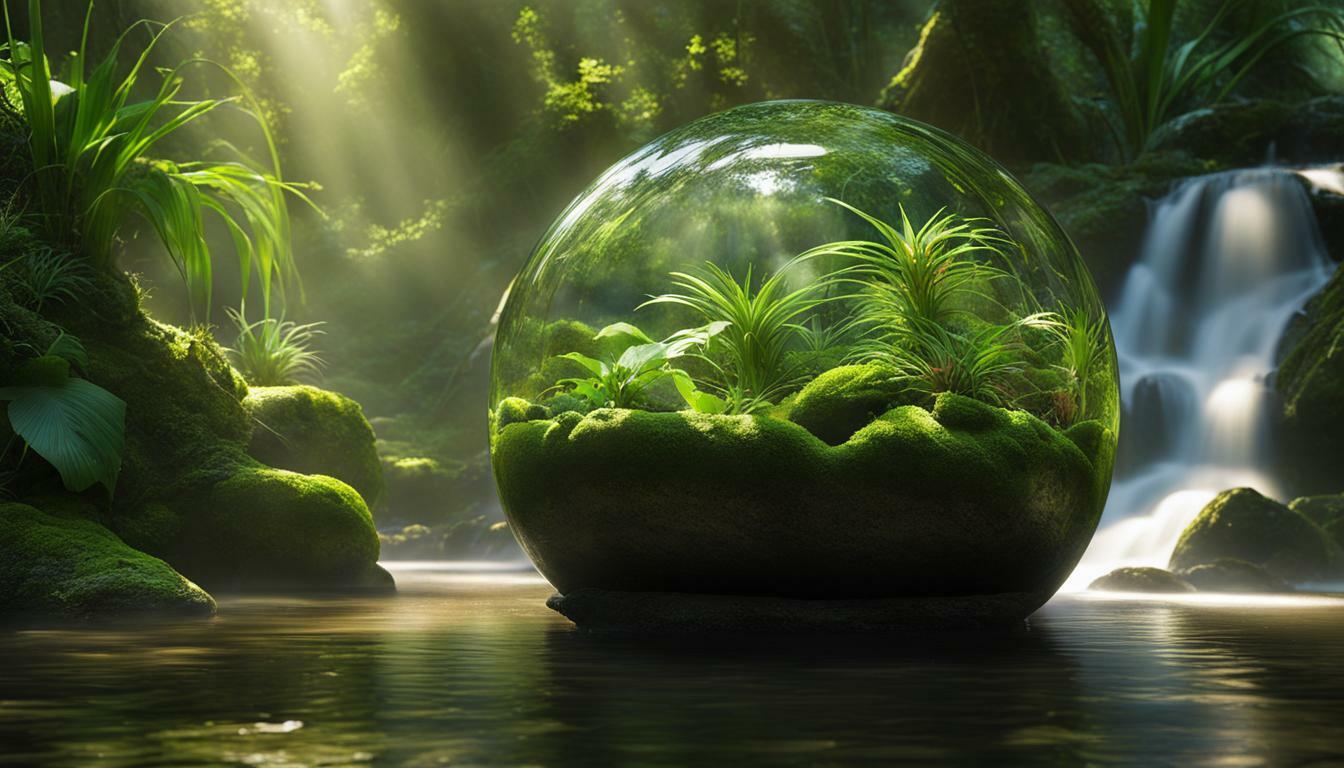Air plant terrariums are a unique and easy way to bring nature into your home, creating a tranquil oasis of greenery. These self-sustaining ecosystems don’t require soil to grow and thrive, making them low-maintenance options for plant enthusiasts and those without a green thumb.
To create your own air plant terrarium, you’ll need a few essential materials. Start with a terrarium container, which can be glass or any other transparent material that allows light to pass through. Next, layer sand or gravel at the bottom for proper drainage. Activated charcoal can be added to purify the air inside the terrarium, while moss helps retain moisture.
Now, it’s time to add your air plants, the star of the show. These unique plants have specialized structures that allow them to absorb nutrients and moisture from the air. Place them gently within the terrarium, arranging them in a visually pleasing manner. You can also add decorative elements, such as rocks, driftwood, or seashells, to enhance the overall aesthetic.
Caring for your air plant terrarium is relatively simple. Water your plants by misting them once or twice a week, ensuring that they are thoroughly moistened but not soaked. Place your terrarium in a location with bright, indirect light, such as near a window. Rotate the terrarium every few days to ensure even exposure to light. Fertilize your air plants occasionally with a diluted fertilizer specifically formulated for air plants.
With proper care and maintenance, your air plant terrarium will thrive and provide a visually appealing and calming environment. These terrariums have many benefits, including air purification and improving indoor humidity levels. Plus, they serve as beautiful natural decor pieces that can be showcased in various spaces throughout your home.
- Air plant terrariums are self-sustaining ecosystems that bring nature into your home.
- They don’t require soil to grow and thrive, making them low-maintenance options.
- To create your own air plant terrarium, you’ll need a terrarium container, sand or gravel for drainage, activated charcoal for air purification, and moss for moisture retention.
- Air plants have unique structures that allow them to absorb nutrients and moisture from the air.
- Care for your air plant terrarium by misting them regularly, providing bright indirect light, and fertilizing occasionally.
What are Air Plant Terrariums?
Air plant terrariums are miniature ecosystems that house air plants, also known as tillandsia, without the need for soil. These unique creations bring a touch of nature into your home and require minimal maintenance. Unlike traditional plant setups, air plant terrariums rely on air and water to thrive, making them a great option for plant lovers without a green thumb.

To create your own air plant terrarium, you’ll need a few key materials. Start with a terrarium container, which can be a glass jar, vase, or any other transparent vessel that allows for good air circulation. Add a layer of sand or gravel at the bottom for drainage. This helps prevent water from sitting at the roots of the plants and causing rot. Next, add a layer of activated charcoal, which acts as a natural air purifier by absorbing toxins and odors. Finally, add a layer of moss, which helps retain moisture and provides a natural aesthetic.
Once you have the base set up, it’s time to add your air plants. Arrange them creatively in the terrarium, considering their colors, shapes, and sizes. You can also add decorative elements such as rocks, shells, or small figurines to enhance the visual appeal.
Caring for an air plant terrarium is fairly simple. Water the plants once or twice a week by misting them with water or by soaking them in a bowl of water for about 10-15 minutes. Place your terrarium in a bright area with indirect sunlight, as air plants thrive in bright, filtered light. Fertilize sparingly, using a diluted liquid fertilizer once a month. To promote even growth, rotate the terrarium occasionally to ensure all sides of the plants receive equal light exposure.
| Materials for Creating an Air Plant Terrarium |
|---|
| Terrarium container |
| Sand or gravel for drainage |
| Activated charcoal for air purification |
| Moss for moisture retention |
| Air plants |
| Decorative elements (rocks, shells, figurines) |
Creating Your Own Air Plant Terrarium
To create your own air plant terrarium, gather the essential materials and follow these simple steps:
- Select a suitable terrarium container that allows for proper air circulation and has a removable lid or opening for maintenance.
- Add a layer of sand or gravel to the bottom of the container. This will help with drainage and prevent water from accumulating at the roots of the air plants.
- Place a thin layer of activated charcoal on top of the sand or gravel. The activated charcoal will help to absorb any impurities in the air and keep it clean and fresh.
- Add a layer of moss on top of the charcoal. The moss will help to retain moisture and create a humid environment for the air plants.
- Carefully arrange your air plants on top of the moss, making sure to leave enough space between them for growth. You can use tweezers or your fingers to position them securely.
- Once the air plants are in place, you can add decorative elements such as rocks, seashells, or small figurines to enhance the visual appeal of your terrarium.
- Place your terrarium in a location with bright, indirect light. Avoid placing it in direct sunlight, as this can scorch the air plants.
- Maintain your terrarium by watering the air plants once or twice a week. Use a spray bottle to mist the plants, ensuring that they are evenly moist but not soaked.
- Rotate the terrarium every few weeks to ensure that all sides of the air plants receive equal light exposure.
With these simple steps, you can create a beautiful and self-sustaining air plant terrarium that will bring a touch of nature into your home.
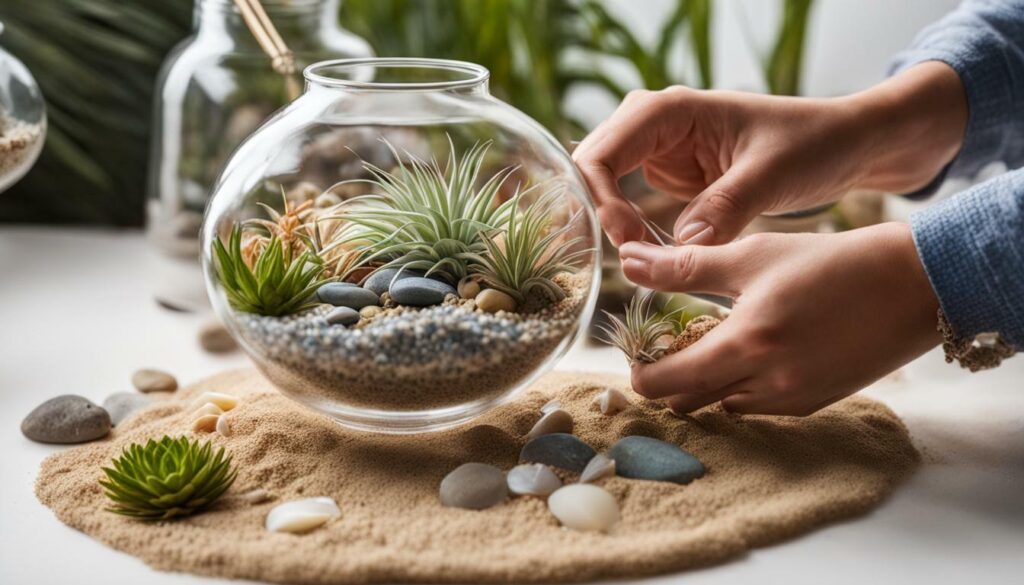
Proper care and maintenance are essential for the health and longevity of your air plant terrarium. Here are some additional tips to keep in mind:
- Monitor the moisture levels in your terrarium. Overwatering can lead to root rot, while underwatering can cause the air plants to dry out and wither.
- Keep an eye out for any signs of pests, such as spider mites or mealybugs. If you notice any infestations, gently remove the affected air plants and treat them accordingly.
- Regularly clean the glass walls of your terrarium to remove any dust or residue that may accumulate over time. This will ensure that your terrarium remains clear and visually appealing.
- If you notice any dead or yellowing leaves on your air plants, carefully remove them to maintain the overall health and appearance of your terrarium.
By following these care tips and providing the necessary attention, your air plant terrarium will thrive and continue to bring beauty and tranquility to your living space.
| Materials | Steps |
|---|---|
| Terrarium container | Select a suitable container with good air circulation. |
| Sand or gravel | Add a layer for drainage. |
| Activated charcoal | Place a layer for air purification. |
| Moss | Add a layer for moisture retention. |
| Air plants | Arrange them securely on top of the moss. |
| Decorative elements | Enhance the visual appeal with rocks, seashells, or figurines. |
| Light | Place in a location with bright, indirect light. |
| Water | Mist the air plants once or twice a week. |
| Rotation | Rotate the terrarium every few weeks for balanced growth. |
Care Tips for Air Plant Terrariums
Taking care of your air plant terrarium is simple with these easy-to-follow care tips. Air plants are unique in that they don’t require soil to grow, making them low-maintenance options for plant lovers. To ensure the health and longevity of your terrarium, follow these guidelines:
- Watering: Air plants absorb moisture through their leaves, so it’s important to mist them with water every 2-3 days. Alternatively, you can soak them in a bowl of water for 10-15 minutes once a week. Be sure to shake off any excess water to prevent rotting.
- Lighting: Place your terrarium in a bright but indirect light location. Air plants thrive in filtered sunlight or fluorescent lighting. Avoid placing them in direct sunlight as it can scorch their delicate leaves.
- Fertilizing: While air plants don’t require frequent fertilization, you can give them a boost by lightly misting them with a diluted air plant fertilizer once a month. Follow the instructions on the fertilizer packaging for proper dilution ratios.
- Rotating: Air plants tend to grow towards the light, so it’s important to rotate them every few weeks to ensure even growth. This will prevent your terrarium from becoming lopsided or one-sided.
By following these care tips, you can create a thriving air plant terrarium that adds beauty and tranquility to your home. Remember to observe your plants closely and adjust their care routine as needed. Enjoy the process of nurturing your own self-sustaining green oasis.
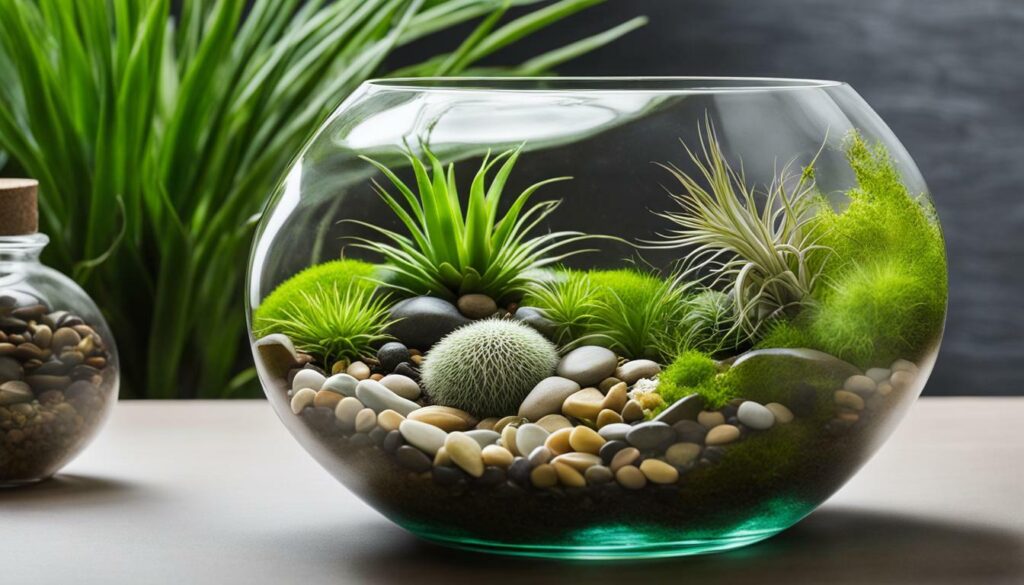
One common mistake is overwatering. Air plants are susceptible to root rot, so it’s crucial to ensure proper drainage and avoid allowing water to sit in the bottom of the terrarium. Additionally, using tap water with high mineral content can cause build-up on the leaves, hindering their ability to absorb nutrients. Consider using filtered or distilled water for misting or soaking your air plants.
Another mistake is placing air plants in areas with insufficient light. While they can tolerate lower light conditions, inadequate lighting can lead to weak growth and poor health. If you notice your air plants becoming pale or stretching towards the light, it’s a sign that they need more illumination.
| Watering | Lighting | Fertilizing | Rotating |
|---|---|---|---|
| Mist every 2-3 days or soak once a week | Place in bright indirect light | Use diluted air plant fertilizer once a month | Rotate every few weeks |
Benefits of Air Plant Terrariums
In addition to their visual appeal, air plant terrariums offer numerous benefits for both your home and well-being. These unique and self-sustaining ecosystems can purify the air in your space, improving the overall air quality. Air plants have the ability to remove toxins and impurities from the air, creating a healthier environment for you and your family. They absorb carbon dioxide during photosynthesis and release oxygen, helping to increase the oxygen levels in your home.
Air plant terrariums also have the ability to improve indoor humidity levels. The plants transpire, which means they release moisture into the air, increasing the humidity in drier environments. This can be especially beneficial during the winter months when indoor heating systems can dry out the air and cause discomfort. By having air plant terrariums, you can create a more balanced and comfortable atmosphere in your home.
Furthermore, air plant terrariums provide a visually appealing and calming environment. The lush green foliage of the air plants can add a touch of nature to any space, creating a sense of tranquility and relaxation. Studies have shown that being surrounded by greenery can reduce stress and anxiety, improve mood, and increase productivity. By incorporating air plant terrariums into your home decor, you can create a peaceful oasis to escape to.
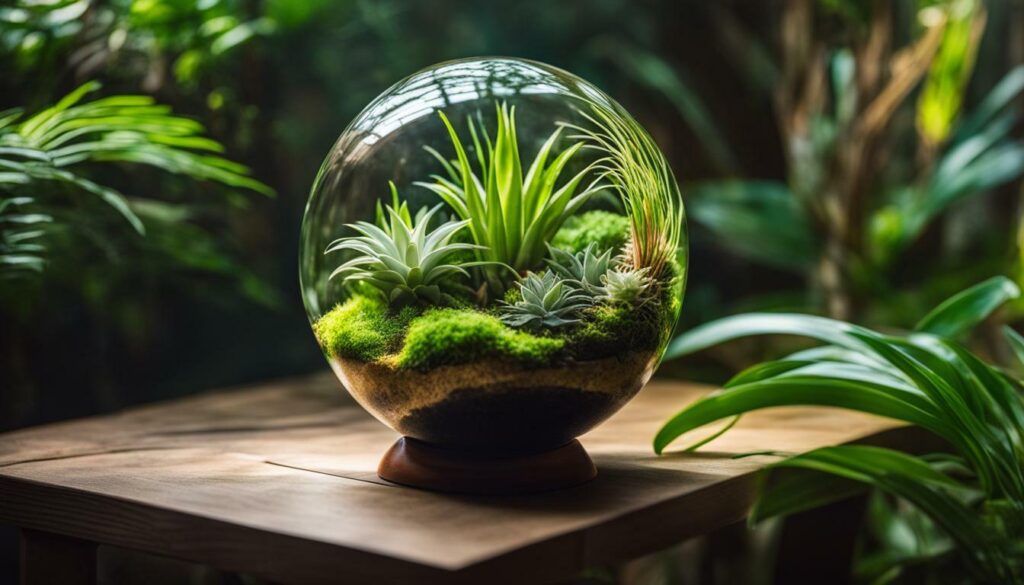
With their low-maintenance nature, air plant terrariums are perfect for those without a green thumb. They require minimal watering and can thrive in a variety of lighting conditions, making them suitable for different areas of your home. The versatility and beauty of air plant terrariums make them a popular choice for both experienced and novice plant enthusiasts.
Summary
Air plant terrariums offer a range of benefits for your home and well-being. They purify the air, increase indoor humidity levels, and create a visually appealing and calming environment. With their low-maintenance nature, air plant terrariums are a great choice for anyone looking to bring a touch of nature into their home. So why not create your own self-sustaining oasis and enjoy the beauty and benefits of air plant terrariums?
Decorating Your Air Plant Terrarium
Get creative and add your personal touch to your air plant terrarium with these decoration ideas. The beauty of air plant terrariums lies not just in the plants themselves, but also in how you choose to showcase them. By incorporating different elements, you can create a unique and visually appealing display that complements your personal style and enhances the overall aesthetic of your space.
One idea is to utilize natural elements such as rocks, driftwood, or seashells. These can be strategically placed within the terrarium to create interesting textures and visual interest. Not only do these elements add a touch of nature, but they also provide a sense of tranquility and evoke a feeling of being in a natural oasis.
To further enhance the beauty of your air plant terrarium, consider using various terrarium container styles. You can choose from glass containers, geometric terrariums, hanging orbs, or even repurpose vintage jars or vases. The choice of container can greatly influence the overall look and feel of your terrarium, so make sure to choose one that complements your personal taste and the existing decor of your space.
| Decoration Ideas | Image |
|---|---|
| Add colorful pebbles or sand | 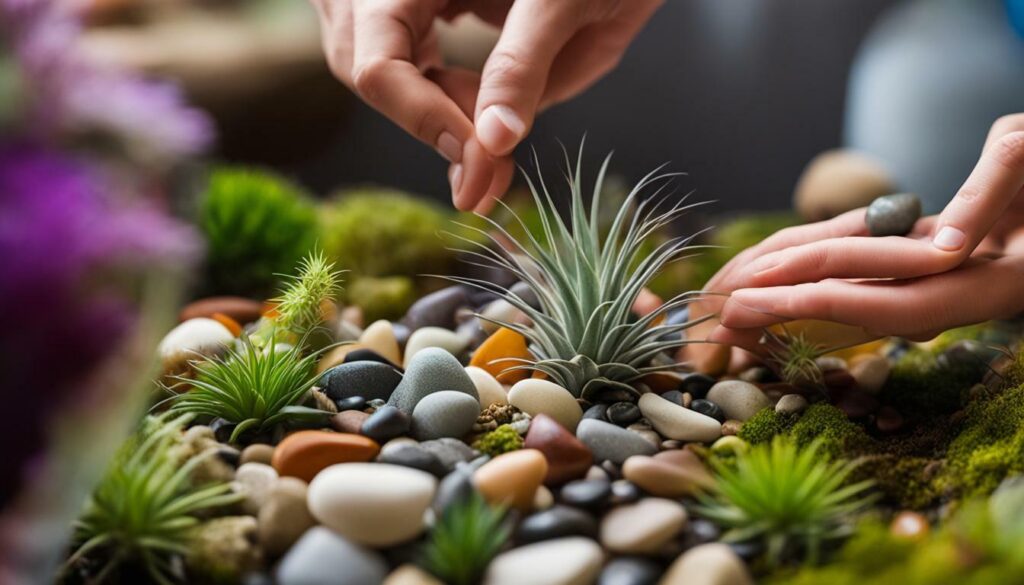 |
| Hang air plant terrariums using macrame hangers |  |
| Create a miniature fairy garden within your terrarium |  |
Don’t be afraid to experiment and let your creativity shine when it comes to decorating your air plant terrarium. The possibilities are endless, and you can always change or rearrange the elements to refresh the look whenever you desire. By infusing your personal style into the design, you’ll create a truly unique and captivating display that will delight both you and your guests.
Showcasing Air Plant Terrariums in Different Spaces
Discover how air plant terrariums can transform different spaces in your home into green havens. Whether you have a spacious living room, a cozy bedroom, a serene bathroom, or a productive office, air plant terrariums can add a touch of nature and beauty to any area.
In the living room, create a focal point by placing a large air plant terrarium on a coffee table or display shelf. Choose a container that complements your existing decor and fill it with decorative elements like rocks, seashells, or driftwood. The vibrant green foliage of the air plants will bring life and color to your living space, creating a peaceful and inviting atmosphere.
For the bedroom, create a calming oasis by incorporating air plant terrariums on your nightstand or dresser. Opt for smaller terrariums with soft lighting to create a soothing ambiance. You can also hang air plant terrariums from the ceiling or mount them on the wall for a unique and eye-catching display. The natural beauty of the air plants will create a tranquil environment, promoting relaxation and better sleep.
In the bathroom, air plant terrariums can add a touch of freshness and humidity. Place them on the windowsill or hang them near the shower for a spa-like experience. The moisture in the air will help keep the air plants healthy and thriving. Consider using transparent containers and filling them with colorful pebbles or glass beads to create a stunning visual effect.
In the office, air plant terrariums can liven up your workspace and enhance productivity. Place them on your desk or shelves to bring a sense of calm and tranquility amidst the hustle and bustle. The air plants’ ability to purify the air will also help create a healthier and more invigorating work environment.
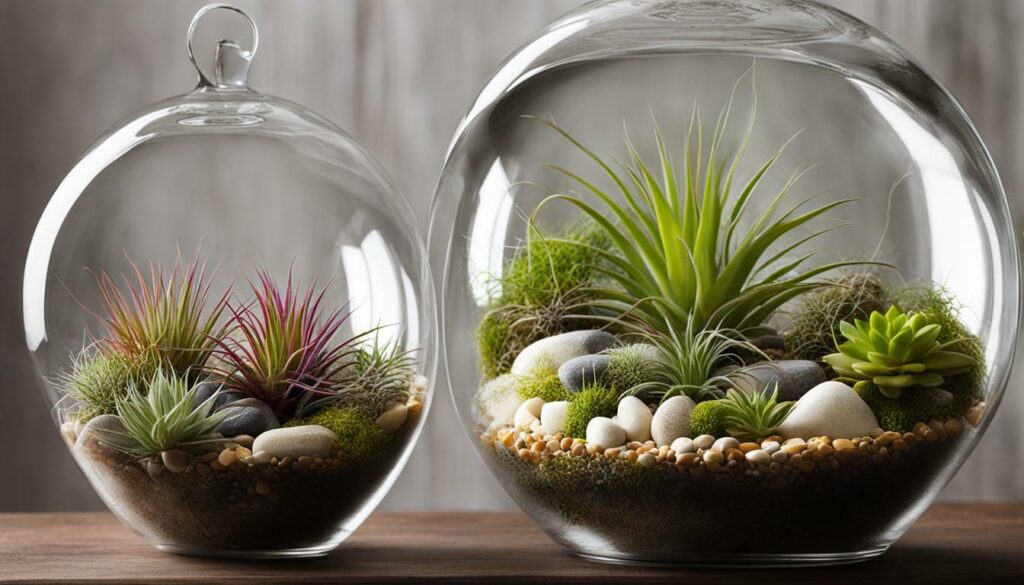
| Space | Ideal Location | Decor Ideas |
|---|---|---|
| Living Room | Coffee table or display shelf | Rocks, seashells, driftwood |
| Bedroom | Nightstand or dresser | Soft lighting, hanging or wall-mounted |
| Bathroom | Windowsill or near the shower | Transparent containers, colorful pebbles or glass beads |
| Office | Desk or shelves | Purifying the air, promoting focus |
Troubleshooting Common Issues with Air Plant Terrariums
Don’t let common issues discourage you – here’s how to troubleshoot and overcome challenges with your air plant terrariums. By understanding and addressing these problems, you can maintain healthy and thriving air plants in your terrarium.
1. Overwatering: Air plants are susceptible to root rot if they are consistently exposed to excess moisture. To avoid overwatering, allow the plants to dry completely between waterings. Only mist or soak them once a week, ensuring that any excess water drains out of the terrarium.
2. Inadequate lighting: Air plants require bright, indirect light to thrive. If your terrarium is in a low-light area, consider supplementing the natural light with artificial lighting, such as fluorescent or grow lights. Position the terrarium near a window, but avoid placing it directly in the path of intense sunlight, as it can scorch the plants.
3. Pest infestations: Although air plants are generally resistant to pests, they can occasionally attract unwanted visitors like aphids or mealybugs. If you notice any signs of infestation, such as tiny pests or sticky residue on the leaves, act promptly. Remove the affected plants from the terrarium, rinse them thoroughly under running water, and treat them with an organic insecticidal soap. Quarantine the plants for a few weeks to ensure that the infestation has been eradicated before reintroducing them to the terrarium.
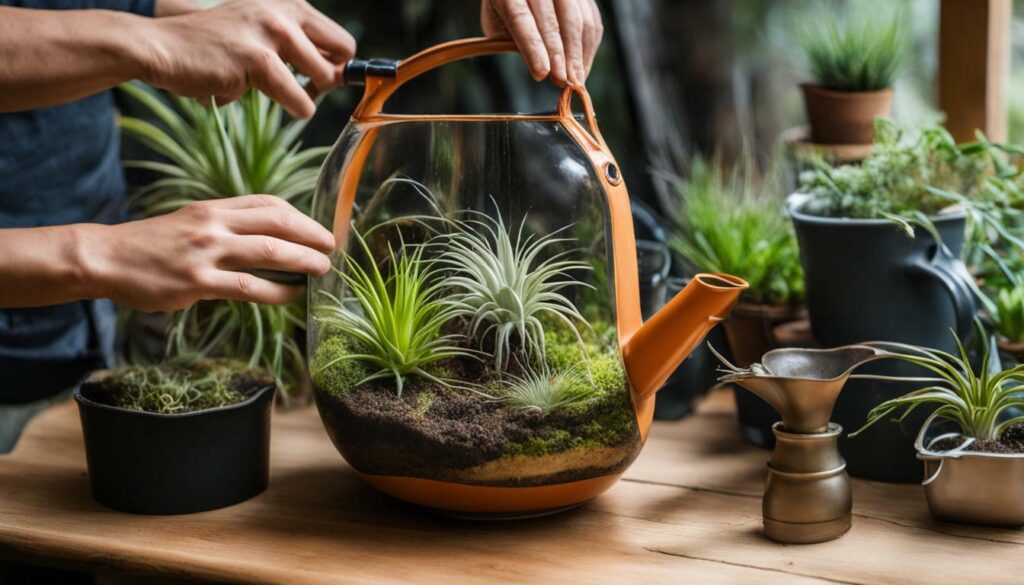
Remember, troubleshooting is part of the journey in caring for air plant terrariums. By understanding these common issues and taking appropriate measures, you can create a thriving and visually appealing oasis in your own home.
Conclusion
Embrace the beauty and simplicity of air plant terrariums as you create your own flourishing oasis. Air plant terrariums offer a unique and easy way to bring nature into your home without the need for soil or extensive maintenance. These low-maintenance plants are perfect for those without green thumbs, providing a stunning display of greenery and tranquility.
To create your own air plant terrarium, you will need a few essential materials. Start by selecting air plants, which require minimal care and can thrive without soil. Choose a terrarium container that suits your style and complements your space. Fill the container with sand or gravel for proper drainage, followed by a layer of activated charcoal to purify the air. Moss can be added to retain moisture and create a lush environment for your air plants.
Once your terrarium is set up, taking care of your air plants is easy. Water them regularly by misting or soaking them, ensuring they receive enough moisture without becoming waterlogged. Place your terrarium in a location that receives bright, indirect light to promote healthy growth. Rotate the plants occasionally to ensure they receive even light exposure. And don’t forget to fertilize them occasionally, following the recommended dilution instructions for air plants.
With a little care and attention, your air plant terrarium will thrive and bring natural beauty to any space. Experiment with different decorative elements to personalize your terrarium and enhance its aesthetic appeal. Whether you showcase it in your living room, bedroom, bathroom, or office, your air plant terrarium will create a visually appealing and calming environment that you can enjoy every day.
Are Air Plant Terrariums Included in the Various Types of Terrariums?
Yes, air plant terrariums are included in the various types of terrariums. They are unique because they do not require soil to grow, making them low-maintenance and easy to care for. Air plant terrariums are a popular choice for those looking to add a touch of nature to their indoor space.
FAQ
What are air plant terrariums?
Air plant terrariums are self-contained ecosystems that house air plants, also known as Tillandsia. Unlike traditional plants, air plants do not require soil to grow. They extract nutrients and moisture from the air, making them unique and low-maintenance options for indoor gardening.
How do I create my own air plant terrarium?
To create your own air plant terrarium, you will need a terrarium container, sand or gravel for drainage, activated charcoal for air purification, moss for moisture retention, air plants, and decorative elements. Layer the sand or gravel at the bottom of the container, followed by activated charcoal and moss. Then, place your air plants and add any decorative elements you desire.
How do I care for my air plant terrarium?
Air plant terrariums require regular watering, proper lighting, occasional fertilizing, and plant rotation. Water the air plants by misting them with water or soaking them in water for a short period. Provide bright, indirect light for their growth and rotate the plants regularly to ensure even exposure to light.
What are the benefits of air plant terrariums?
Air plant terrariums offer several benefits, including air purification, increased indoor humidity levels, and a visually appealing and calming environment. They can help filter toxins from the air and improve overall air quality in your home or office.
How can I decorate my air plant terrarium?
You can personalize your air plant terrarium by incorporating natural elements like rocks, driftwood, or seashells. Additionally, you can experiment with different styles and sizes of terrarium containers to suit your aesthetic preferences.
Where can I showcase my air plant terrarium?
Air plant terrariums can be showcased in various spaces such as living rooms, bedrooms, bathrooms, and offices. Consider the size and design of the terrarium to match the specific area and create a visually pleasing display.
What are common issues with air plant terrariums and how can I troubleshoot them?
Common issues with air plant terrariums include overwatering, inadequate lighting, and pest infestations. To address these issues, make sure to water the plants sparingly and provide sufficient indirect light. If pests appear, you can remove them manually or use natural remedies like diluted neem oil.

